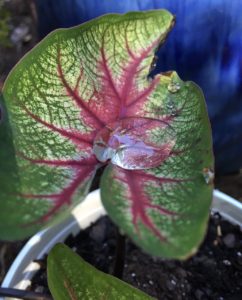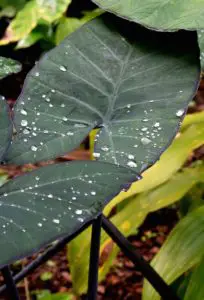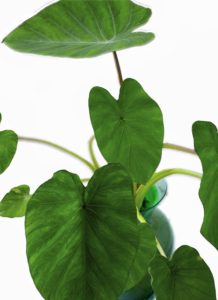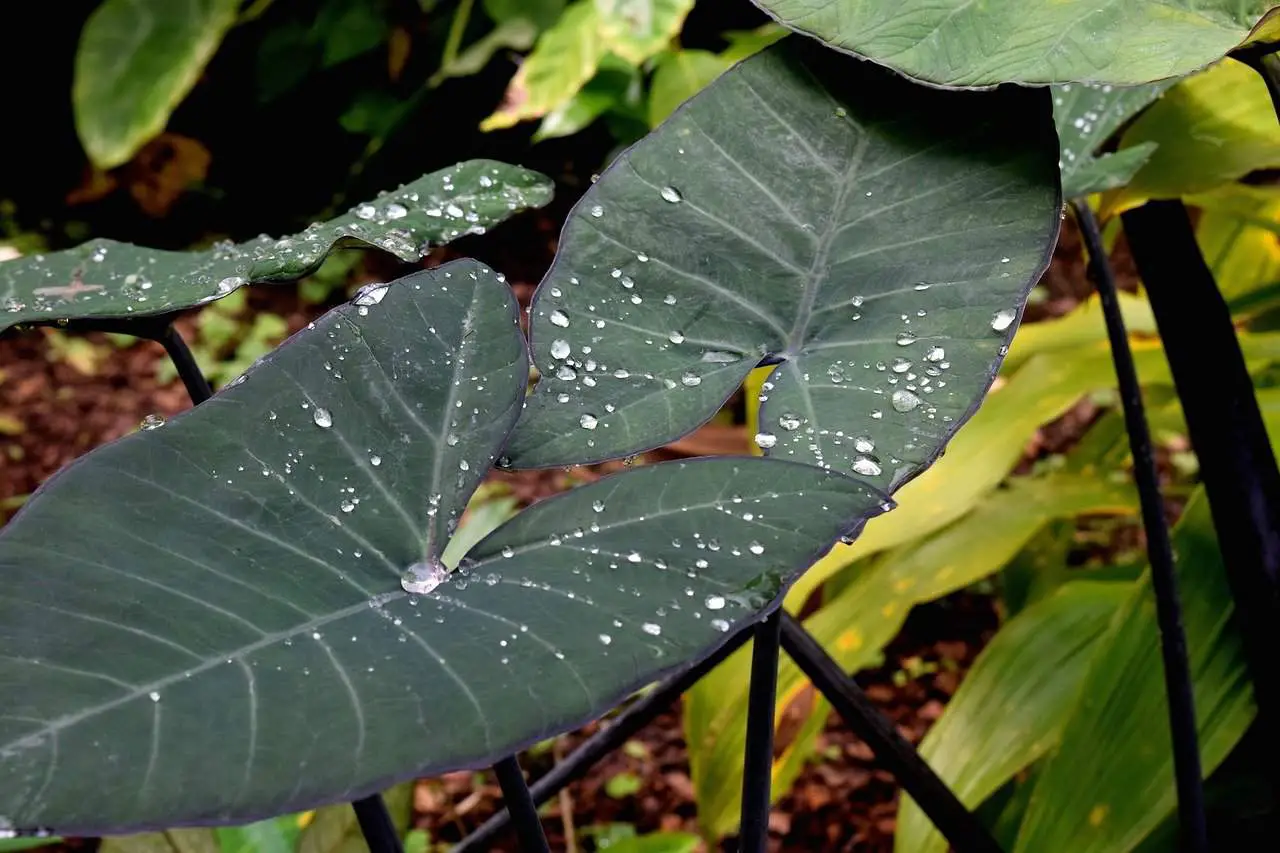Some links in the post are affiliate links and I get a commission from purchases made through some links found in the post.
The Elephant Ears, also known as Kris Plant or African Mask Plant, makes for a great house plant.
It gives rise to beautiful foliage and can grow to tall heights if grown under the right conditions. At present, there are more than 70 species of this plant, which is native to Asia.
The species vary in their leave structures such that some feature glossy appearances while others have velvety leaves.
You thus have quite an array from which to choose when selecting a species for your home or garden.
As with any plant, you always have to consider how well a species will do as the seasons change.
With some Elephant Ears species, the plants die back, retreat or become dormant when the temperatures take a turn for the worse.
You can tell that the plant has reached this dormant stage when everything above the soil starts retreating.
In this case, you should continue caring for the plant as the root system will still be intact.
To care for a Elephant ear plant over winter, you should not add fertilizers to the soil. Come spring, the plant will bounce back, producing new shoots in readiness for the new season.
In this piece, we will dig a little deeper on how to care for your Elephant Ear plant in winter as well as other seasons. Let’s get started:
How to Care for Your Elephant Ear Plant Over Winter?
We will start with how you should handle your species based on where you live. Please note that these practices apply to people who grow their plants in the outdoors.
Hardiness Zones 1-6
 In these regions, the temperatures can get pretty harsh and you need to move your plant indoors before winter begins. So, how should you do it?
In these regions, the temperatures can get pretty harsh and you need to move your plant indoors before winter begins. So, how should you do it?
Wait for the first frost and cut the stems to a height of six inches. Place the tubers in bag, pot, or any other suitable container and cover them with soil and peat moss.
That will allow them to enjoy a suitable growing medium and to keep thriving despite the temperatures.
You can now move this container to a cool and dark place in your home.
Keep watering the soil as needed as the plant continues to remain dormant during the cold months. The soil should be damp but not wet; else, the roots can rot.
Once the last frost has passed, you can now move the tubers back to the ground and care for them as needed to allow them to thrive.
Hardiness Zones 7-11
If you live in such a climate, you are in luck as you do not have to cut back the plant during winter.
The plants can remain in the ground. However, you must protect them throughout winter to keep them safe from the drafts and ice.
During winter, the stems of the plants will naturally die back and retreat as the frost increases. Do not cut them.
Instead, allow this natural process to take place. Once this happens, cover the plants with leaves, lawn grass and any other materials that can serve as protective mulch.
These materials will provide enough insulation to allow the roots to remain healthy for growth next season.
Once the last frost passes, you can remove the mulch, paving the way for the development of new shoots.
You may also like: How to care for a monstera
How Cold can Elephant Ears Tolerate?
Elephant Ears plants do best in temperatures in the ranges of 15 – 26°C. The plant can survive temperatures lower than 15°C but only for a limited time.
If these temperatures prevail, the plant will become dormant and will lose its leaves. Thus, if you are keeping the plant indoors, you need to protect it from cold drafts that are prevalent in the winter.
For outdoor plants in regions where temperatures fall below this range, moving the plants indoors is the best option.
Do Elephant Ear Plant need to be Dug up for Winter to Care for Them?
You can choose to move the plants indoors where you can regulate the temperatures.
Another option would be to dig up the tubers and store them in readiness for the spring. How can you go about this?
Start by digging up the tubers. You can do this before or after the first frost when foliage has died back.
Please note that you should not allow the ground to freeze before harvesting the tubers. You should also take precautions to ensure that the tubers do not suffer damage during harvesting.
If you bruise them, they are likely to rot, thus undoing all the hard work you have put into collecting them.
The best way to be safe is to dig a foot away from the plant, giving you enough safe space.
Once the tubers are out of the ground, you need to clean them, which you can do in a bucket of water.
The goal here is to remove the excess dirt on the surface. To be gentle, use only your hands to scrub off the dirt. Using tools can bruise the tubers, leading to rot as we earlier covered.
Depending on when you dig up the tubers, they may still have some foliage on them. You need to get rid of this foliage as well as cut the stalks about two inches above the tuber.
What you leave will dry out and eventually fall off. You can also trim the excess roots, though this is not necessary.
You can now dry the tubers, to allow the skin to be tough enough to resist the effects of the elements. It also enables the tubers to resist bruising which can cause root rot.
Dry the tubers in a warm, dark and dry place, ensuring there is adequate aeration to prevent rotting.
Once the skins feel tough to the touch, you can move the tubers to storage. For this, you can wrap the tubers in breathable papers and store them in a cool and dry place.
Monitor their appearance during winter and where you see any signs of root rot, remove the affected tuber before it can affect the rest.
Once the last frost has passed, you can move the tubers back into the ground and care for them to allow them to thrive.
If you would prefer to give them extra care, you can start by planting them in pots as winter comes to an end. That way, you can transplant them when they have already stabilized.
How to Move your Elephant Ear Plant Indoors for Winter to Care for it
 If storing tubers does not appeal to you, you can consider moving the plants indoors where you can exercise control over the growing conditions.
If storing tubers does not appeal to you, you can consider moving the plants indoors where you can exercise control over the growing conditions.
Move the plants to pots which you should place towards a south-facing window, enabling them to get adequate light.
The temperature should lie in the ranges of 15 – 26°C, and watering should take place frequently.
You should also look into the humidity as these plants do best in humid conditions.
Where you use electric heaters in the room, you may find that controlling humidity may prove to be a problem.
You can make up for this, though, by creating mini-greenhouses to house the plants. Another option would be to invest in a humidifier.
Elevating the pot also helps such that you can place some pebbles below the pot, thus creating room between the pot and saucer.
This medium increases humidity and also allows for added drainage, keeping root rot at bay.
If you’re enjoying this article, check out our article on what is a scindapsus treubii dark form.
Recommended Care Practices
Once the last frost has passed, you need to provide the plants with the best care practices for them to thrive.
If kept in good conditions, some species can reach heights of 1.2 meters. Below are the recommended growing conditions:
Lighting
Elephant ears do well in bright light, though it should not be direct. Direct sunlight burns the leaves. Low lighting is also not ideal, and you need to strike a balance between these two extremes.
Watering
The soil should be damp but not wet. The rule of thumb is to check the top two inches of the soil. If these are dry, you can add water to the pot.
If not, you should not add more water. During winter, you need to reduce watering frequency as the plant will not need moisture as much.
Repotting
Once the plant has produced many offsets, you can repot it. Please do this in spring when the conditions are ideal, ensuring that you remove offsets to allow for division.
Humidity
Elephant ears do well in high humidity. For indoor plants, you can invest in humidifiers or create greenhouse-like conditions to achieve this effect.
Pruning
You need to stay on top of pruning and remove any affected plant parts before the problem can spread to other parts of the plant. These include diseased leaves.
Temperature
As earlier mentioned, the temperature ranges should be between 15 – 26°C. Any lower than this and the plant can go into dormancy.
Final Thoughts: How to Care for Your Elephant Ear Plant Over Winter
 To care for your elephant ear plant in winter should not be that much of a hassle. Start by determining your hardiness zone and gauging how well the plants can do in the winter.
To care for your elephant ear plant in winter should not be that much of a hassle. Start by determining your hardiness zone and gauging how well the plants can do in the winter.
Where the conditions are unfavourable, you can either pot the plants and move them indoors or collect their tubers and store them for the spring.
For plants that continue growing in winter, ensure that you cut back on the watering schedule.
Happy Gardening!
Before you go, here are some more related articles I encourage you to read below to help solve more of your gardening issues:
What are the Varieties of Rubber Plants


